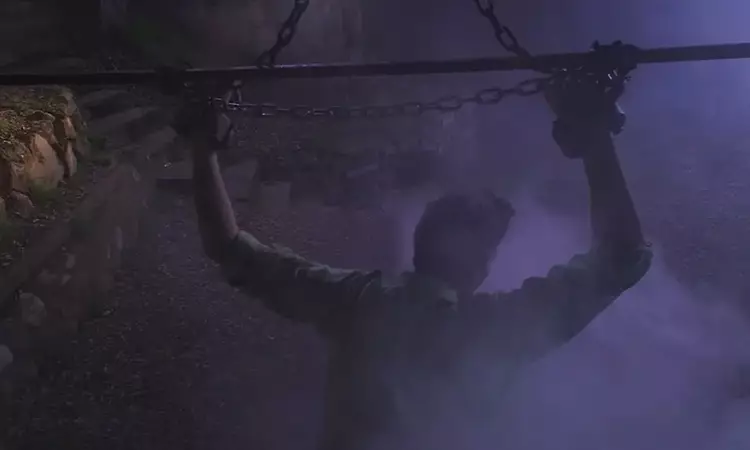“Cursed in Baja,” a film crafted by Jeff Daniel Phillips, weaves an intricate tale that explores the themes of entrapment, redemption, and cyclical patterns in life. The narrative begins dramatically with a prison guard leading the inmate Pirelli, setting the stage for what initially appears to be his execution. However, this moment quickly unravels into a collage of memories and surreal events that illuminate the protagonist’s struggles and his precarious position in society. By contrasting the moments of Pirelli’s past with his present reality, the film reflects the complexities of human behavior and the inescapable grip of one’s history.
The storytelling in “Cursed in Baja” is characterized by a non-linear narrative structure that disrupts the conventional flow of time. Pirelli’s journey through the arid desert is interspersed with haunting imagery and memories that challenge the viewer’s perception of reality and time. These broken sequences serve a dual purpose: they illuminate Pirelli’s troubled past while also illustrating how memories can distort one’s present.
Amidst the chaos, moments featuring Helen Kemper and a depiction of violence serve to deepen our understanding of Pirelli’s psyche. He exhibits an obsessive connection to Helen, hinting at his desire for connection in a world where he feels alone and marginalized. This juxtaposition—between vivid recollections of passion and stark representations of violence—underscores a critical commentary on the often blurred lines between love and destruction.
The character of Jill Garvey, Pirelli’s parole officer, introduces a sobering warning about the dangers of falling back into old habits. Her admonitions highlight the societal expectations placed on ex-convicts and the prejudices they face. Pirelli’s struggle to forge a new identity outside of prison resonates with many who grapple with the daunting task of reintegration into society.
The cyclical nature of his existence is poignantly illustrated through his job offer from the dying patriarch Robert Kemper. Here lies a tragic twist: Pirelli is tasked once again with locating a lost family member, mirroring past failures and hinting that some paths are destined to repeat. The arresting idea that history is condemned to repeat itself sends ripples of despair throughout the film, questioning whether true redemption is achievable or merely an illusion.
Complex Characters: Heroes and Villains
Pirelli’s interactions with the eclectic cast of characters—the local gangster Satanás, Quinn’s deceitful girlfriend Jocelyn, and the enigmatic Russian actress—further complicate his journey. Each character embodies distinct qualities that contribute to the narrative’s development and Pirelli’s ongoing battle with his inner demons. For instance, characters like Satanás reveal the pervasive corruption within the landscape, underscoring the temptation and moral decay that exist in Baja.
Moreover, the film presents Pirelli as an unreliable narrator, leaving audiences questioning what is real versus a projection of his troubled mind. This ambiguity raises essential questions about morality and intent: Are Pirelli’s violent impulses a reflection of his true nature, or are they an exaggerated consequence of his tormented psyche? The film effectively blurs the line between victim and perpetrator, allowing space for rich interpretation of Pirelli’s actions.
One of the more unconventional narrative threads involves the presence of a sacrificial cult and a mysterious creature, the chupacabra, interspersed within the story. The introduction of these elements lends an air of supernatural intrigue but also serves to highlight the themes of sacrifice and the monstrous qualities embedded within humanity. The chupacabra, an embodiment of Pirelli’s fears, becomes symbolic of the predatory forces lurking within society, including the angles of human avarice, brutality, and the inherent desire for self-preservation.
The creature can also be interpreted as an allegory for Pirelli himself—a dark reflection of the impulses he fights to control. This duality adds depth to the film and intensifies the psychological struggle at the narrative’s core, leaving audiences with the haunting realization of how personal demons can wreak havoc in one’s life.
As “Cursed in Baja” progresses, it becomes clear that no character emerges unscathed from their connections to the past. Pirelli’s inevitable return to crime signifies not only a defeat of personal redemption but also a damning commentary on the relentless nature of one’s history. It brilliantly captures how the past can perpetually haunt us while illustrating the broader societal issues faced by those attempting to move forward.
The film’s exploration of cyclical narratives, identity struggles, and the intersection of humanity’s darker impulses presents a compelling portrait of life as an unending fight against the shadows of the past. In the end, “Cursed in Baja” leaves us with a profound question: Can one ever truly escape the inescapable?

